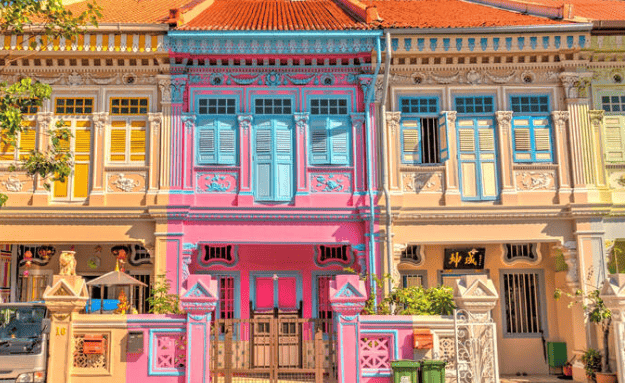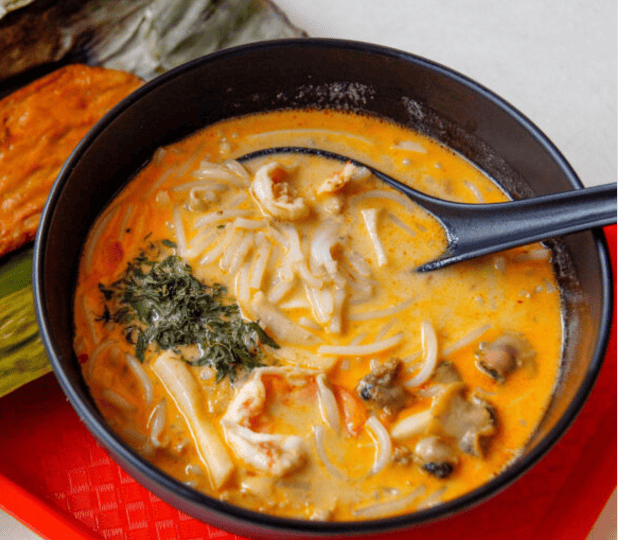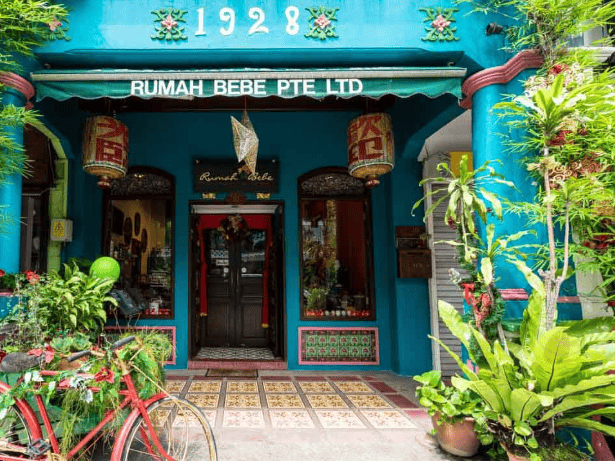Katong is not as popular as Marina Bay, Bugis, and Chinatown in Singapore. However, it offers a unique destination for those wanting to explore a different side of the city, especially for history, culture, and food enthusiasts.

This district is a living representation of Singapore’s traditional Peranakan culture, with a well-preserved 20th-century atmosphere. Once a coconut plantation, it was originally a weekend retreat for the elite.
By the early 20th century, Katong developed into a suburban settlement for the Peranakan community. Today, it still maintains its Peranakan heritage, visible through its old shop-houses and eateries passed down through generations.
Katong is famous as Singapore’s Peranakan food paradise and a place to experience the unique Peranakan culture. Moreover, Katong is Muslim-friendly, making it an excellent choice for those traveling to Singapore. Here are some activities you can enjoy while exploring Katong!
Experience Living Like a Local in Katong
Katong is the perfect area for those wanting to experience everyday life in Singapore. It features many boutique hotels located in residential neighborhoods, offering visitors a taste of local living. This is one of the key attractions of Katong for travelers.
You can live like a local and interact directly with the residents. This area is also a great choice for foodies, as there are legendary Singaporean dishes available around the accommodations.
The hotels in Katong also boast unique Peranakan architecture, making them Instagram-worthy and perfect for photos.
For accommodations, there are several SG Clean-certified hotels in Katong, offering a safe and different experience. Some recommendations include Santa Grand Hotel East Coast, Hotel Indigo Singapore Katong, Champion Hotel, and Village Hotel Katong.
Snap Photos of Iconic Architecture

One of the enjoyable activities you can do in Katong is photo hunting. You can capture interesting street photography subjects or have fun taking selfies in the building’s alleys.
Along Katong and Joo Chiat, you’ll find attractive photo spots featuring the old Peranakan architecture with pastel-colored buildings. There are also murals by local artists, such as the High Tide mural depicting waves along Koon Seng Road.
The mural by Helene Le Chatelier tells the story of Joo Chiat, once a beachside area. It also includes a poem by Christine Chia.
Another mural, *A History of Healing* at the Scanteak Showroom, was created by TYC Studios. This building was once a clinic for mothers and children to improve child survival rates during the war.
There is also the Medleyalley mural, a twin mural on both sides of a yellow wall alley. It features cheerful Peranakan motifs and was created by artists Nicia Lam, Valerie Neo, Novena Angela, and Yillish Lam.
Legendary Culinary Delights

After a fun photo session, it’s time to rest and satisfy your hunger and thirst. Katong is a renowned food destination in Singapore, offering a wide range of legendary Muslim-friendly dishes to try.
One must-try dish when visiting Katong is Laksa. Laksa in Katong is considered a representation of Singapore and stands apart from other types of laksa found in neighboring countries. It consists of white rice noodles in a savory and spicy prawn broth, providing a refreshing taste.
Laksa Katong is typically served with clams and fish cakes, known as otak-otak in Indonesia. Another distinctive feature of Katong Laksa is that the ingredients are bite-sized, making it easy to eat without chopsticks.
There are two legendary laksa stalls in Katong that offer the authentic taste of laksa: 328 Katong Laksa and Kedai Janggut Laksa. Both are Muslim-friendly eateries.
After enjoying laksa, don’t forget to try some Peranakan cakes in Katong. These classic snacks are made with high-quality ingredients and are perfect for breakfast or afternoon tea. Cakes are also a key part of Singapore’s Peranakan food culture, with many recipes passed down through generations.
Some recommended Peranakan cakes in Katong include Ang Ku Kueh, a turtle-shaped cake made from glutinous rice flour with a smooth mung bean filling. Its unique shape symbolizes prosperity.
There’s also Sugee Cake, an almond sponge cake topped with icing sugar. This treat is popular among the Eurasian community, influenced by European cakes.
Innovative Peranakan cakes with premium ingredients like durian are also trending in Singapore. Kue Salat, a two-layer cake made of glutinous rice, pandan cream, and coconut, is now available in a durian version. Other durian-filled treats include Kue Lapis, pineapple tarts (nastar), and mooncakes.
If you’re in the mood for bread, visit Micro Bakery and Kitchen Red House. This charming cafe, with its red-colored, old building, has been around since the 1960s. The bakery specializes in Swiss rolls, and today, the cafe also serves a variety of classic breads like sourdough, tartines, sandwiches, and brownies. The bread is made in small batches to ensure freshness and flavor.
Another must-try is the prata at Mr and Mrs Mohgan’s Super Crispy Prata. This legendary prata shop is famous for its loyal customers who are willing to wait in long queues. On weekends, the wait can be up to 45 minutes for a crispy prata, served with curry sauce and sambal for an extra touch of flavor. Mr. Mohgan, the owner, has been making prata since he was 12 years old, so the taste and texture are guaranteed to be excellent.
Learning About Peranakan Culture

A visit to Katong wouldn’t be complete without understanding Peranakan culture. Katong offers visitors the opportunity to explore and engage in various Baba and Nyonya activities, terms for men and women of the Peranakan community.
The experience is designed to be engaging and interactive, making it educational yet fun. There are three places to learn about Peranakan culture in Singapore: Katong Antique House, The Intan, and the Eurasian Heritage Gallery.
At these places, visitors can find Chinese ancestral altars, collections of ancient ceramics, and photographs of Peranakan families. Booking a private tour at Katong Antique House can enrich your understanding of the culture.
In addition to Katong Antique House, there’s The Intan, a private Peranakan museum. The Intan has received several prestigious awards, including the Singapore Experience Award for Best Attraction in 2016. The museum has been featured on the Discovery Channel and National Geographic.
The Intan offers various interesting packages for visitors, such as location tours, virtual tours, and special classes like tea sessions where visitors learn about Peranakan culture and history. You can also take group photos or even hold pre-wedding photo shoots at The Intan.
Another place to explore Katong’s history is the Eurasian Heritage Centre. While Katong is famous for its Peranakan community, the Eurasian community also settled here. Visitors can learn more about their history at the Eurasian Heritage Centre.
You can explore the journey of immigrants to Singapore and the cultural fusion that still influences the area today. The Eurasian Heritage Centre also offers classes for those interested in Eurasian culture, such as cooking, singing, and traditional Portuguese dance lessons.
Shopping for Peranakan Antiques and Goods

Katong is also a great place to shop for unique items, including clothing and home decor with a vintage twist. Many indie stores here offer antique-themed products, including Rumah Bebe.
Rumah Bebe is one of the most famous shops in Katong, selling Nyonya kebayas, sarongs, and beaded slippers. You can also find Peranakan-themed tableware, food, and souvenirs here.
This store occupies a building from 1928, featuring classic Peranakan design. Rumah Bebe also offers classes and tours to further explain the Peranakan culture.
For something even more unique, visit Cat Socrates, a quirky shop where the shopkeeper is a cute orange cat. This store sells books, home decor, plants, fashion accessories, and Peranakan-themed souvenirs.
